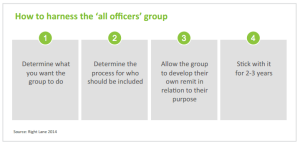Top team off the beam? Engaging the ‘all officers group’
By Dr Marc Levy
Engage the CEO+2 cohort in strategy
In our experience, most organisations, and most executives, are dissatisfied with the strategic engagement of CEO+2 cohort (i.e. the direct reports to the CEO’s direct reports). Engaging the CEO+2 cohort at the start of the strategy process can be particularly useful for idea generation and ensuring strategic alignment with the broader organisation (as well as building the capabilities of the organisation’s future leaders).
Right Thinking
- All officers groups, or senior leadership teams, are a feature of most organisations.
- Getting the most out of an all officers group means giving them direction and focus.
- All officers groups can be particularly useful for brainstorming, alignment and communications, and building capabilities.
Bob Frisch’s book, Who’s in the room (2012), talks about three senior teams with quite distinct roles: the kitchen cabinet (a few executives drawn together by a CEO to make decisions), an executive team, and an ‘all officers group’ (for the next layer of leaders). We have seen this structure at work in most of our clients, and we’ve seen these groups operating with differing levels of success.
In most of the organisations we work with the role of the executive team could be sharpened for greater impact, but in this article the focus is on what Bob calls the ‘all officers group’. In our clients, this group is more commonly referred to as the senior leadership team (SLT) or the senior manager/management group (SMG), although there are numerous names for it.
There are similarities and differences in the ways that the organisations we’ve worked with have set up their all officers groups. Most of these groups are similar in size, say, 20-30, although they can be much larger in our big clients; they frequently include the executive team members’ direct reports; they mostly have alignment to strategy as part of their remit. But other aspects of the way clients engage all officers groups are widely divergent. Some clients use them to accelerate strategy execution, or iron out strategy execution barriers; others use them for leadership development; some use them for brainstorming and idea generation relating to business or process problems; frequently they are predominantly a communications vehicle or conduit to the middle layers of an organisation and below. Organisations have their all officers group meet as rarely as annually and as frequently as monthly.
In our experience, most organisations, and most officers, are dissatisfied with the all officers group. They frequently feel patronised by being used as a communication channel, disconnected from the real strategic decision-making; they believe that their views should be heard and acted upon. Top teams tend to chop and change what they want from the all officers group and alter the composition of it, sometimes without explaining why. We’ve see instances of organisations oscillating between different qualifications for membership – first by place in the hierarchy, then by whether officers are on an emerging talent list, and then back to hierarchy but with a screen based on the number of direct reports officers have (some technical managers with few reports have been excluded).
Our prescription for a successful officers group is simple:
- Work out what you want it to do and who is going to be involved and stick to that for a defined period, say 2-3 years.
- Engage the group in developing its own remit. Negotiate a remit that adds value for the organisation and is exciting and challenging for the officers. The remit should have two to three main themes, but it shouldn’t be too circumscribed. Part of the benefit to the organisation is to see how its members cope with the ambiguity of defining and negotiating their own scope and taking responsibility to deliver something valuable. We agree with Bob Frisch that an all officers group can be very helpful for brainstorming and idea generation, and in our view it is also an ideal site for capability building and bottom up renewal.
- Take it seriously too: give it some power and autonomy; encourage it to take risks and initiate change; give it the resources and support it needs; put proper governance around it; have it agree clear measures of success.
- Then, most importantly, put the acid on it to deliver something to a timetable, with full visibility to the executive team (pitching sessions to the executive can work well), and embed an evaluation of its results in the performance management system.

All officers groups want to, and frequently need to, build their capabilities in strategic thinking, strategic planning and strategic management (Heracleous 1998; Liedtka, 1998). These topics help prepare them for leadership and should also deliver immediate value to the organisation in terms of better businesses cases, more well conceived business plans and budgets, and a better understanding of the context of their and their teams’ work. We suggest to some of our clients that they invest in a number of intensive sessions with the all officers group covering: forces at work in the external environment; envisioning alternative futures; discovering disruptive strategies; operationalising strategic thinking in plans; prioritising and integrating initiatives; resource allocation; managing dependencies; aligning the team; and measurement, monitoring and review.
Some organisations we know have abandoned all officers groups altogether. This is probably a sensible step in some cases, but if organisations are prepared to get behind them to make them work – more pointedly, to give them what they need and ask the officers themselves to make them work – then they can be very valuable forums.
Right Lane is collaborating with Boston-based Strategic Offsites Group, where Bob Frisch is the Managing Partner, on knowledge sharing and professional development initiatives.
References
Frisch, B 2012, Who’s in the room? How great leaders structure and manage the teams around them, Jossey-Bass, San Francisco CA
Heracleous, L 1998, ‘Strategic thinking or strategic planning’, Long Range Planning, vol. 31, no. 3, 481-487
Liedtka, J 1998, ‘Linking strategic thinking with strategic planning’, ‘Strategy and Leadership’, vol. 1, 120-129
For more information contact Marc Levy at marc@rightlane.com.au
© 2014 Right Lane Consulting
